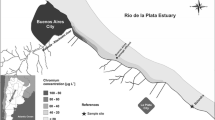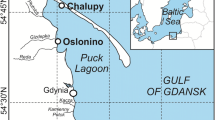Abstract
The ecotoxicological investigations on the resistance of various phytoplankton communities were performed in the Southern Baltic Sea during summer and winter periods. The primary production rate was studied for different Cu concentrations. The enhancement of the toxic effect as well as total biomass and productivity increase were observed for phytocenosis. Total algae biomass on most of the stations increased accordingly to the dinoflagellate growth. Both dinoflagellate impact and relative copper toxic effect declined in the Gdansk Bay opposite to the high total algae biomass observed. We assume the dinoflagellate abundance is linked with the sensitivity of the phytoplankton cells to copper.
Similar content being viewed by others
References
Cobelo-Garca, A. and Prego, R., Land Inputs, Behaviour and Contamination Levels of Copper in a Ria Estuary (NW Spain), Marine Environ. Res., 2003, vol. 56, no. 3, 403–422.
Korb, R.E., Whitehouse, M.J., Thorpe, S.E., and Gordon, M., Primary Production across the Scotia Sea in Relation to the Physic-Chemical Environment, J. Mar. Syst., 2005, vol. 57, nos. 3–4, 231–249.
Mosharov, S.A., Serova, E.M., Korsak, M.N., and Dallakyan, G.A., Ecotoxicological Studies of Phytoplanktonic Communities in the Baltic Sea, Vestn. Mosk. Univ., Ser. Biol., 2005, issue 2, pp. 34–39.
Patin, S.A., Vliyanie zagryazneniya na biologicheskie resursy i produktivnost’ Mirovogo okeana (The Effect of Pollution on the Biological Resources and Productivity of the World Ocean), Moscow, 1979.
Sorokoletova, E.F., Andreev, V.P., Maidan, V.A., Turzhova, E.B., Narikov, B.I., Petreev, I.V., and Alekseev, M.A., The Experience of Using the Green Algae-Based Biotest for Assessing Water Quality, Vodn. Resur., 2000, issue 3, pp. 371–376.
Third Periodic Assessment of the State of the Marine Environment of the Baltic Sea, 1989–1993, Helsinki: HELCOM, 1996, issue 64A.
West, L.J.A., Li, K., Greenberg, B.M., Mierle, G., and Smith, R.E.H., Combined Effects of Copper and Ultraviolet Radiation on a Microscopic Green Alga in Natural Soft Lake Waters of Varying Sissolved Organic Carbon Content, Aquat. Toxicol., 2003, vol. 64, no. 1, pp. 39–52.
Author information
Authors and Affiliations
Corresponding author
Additional information
Original Russian Text © S.A. Mosharov, M.N. Korsak, E.M. Serova, G.A. Dallakyan, 2009, published in Vestnik Moskovskogo Universiteta. Biologiya, 2009, No. 3, pp. 34–39.
About this article
Cite this article
Mosharov, S.A., Korsak, M.N., Serova, E.M. et al. Peculiarities of the copper toxic effect on the phytoplankton communities of the Baltic Sea. Moscow Univ. Biol.Sci. Bull. 64, 121–125 (2009). https://doi.org/10.3103/S0096392509030079
Received:
Published:
Issue Date:
DOI: https://doi.org/10.3103/S0096392509030079




